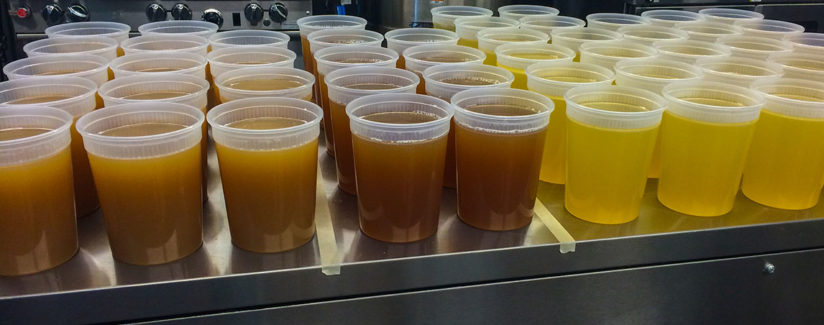
Bone Broth: Magic Elixir or Trendy Soup?
02/22/2016
There’s a new trend advocating the benefits of bone broth, which grandmothers have been making for generations. Bone broth has become a chic food featured at take-out windows run by chefs in major markets, and some claim it can reduce inflammation, speed healing, calm allergies and combat fatigue. But does nutritional science back up this claim? Results are mixed, but Best Food Facts caught up with Julie Garden-Robinson, PhD, RD and Sarah Downs, MBA, RDN to answer our questions about bone broth.
Stock versus Bone Broth
Julie Garden-Robinson says that although sometimes “stock” and “bone broth” are used interchangeably, there are some key differences between the two, according to culinary experts. The main differences? Simmering time and end use.
Dr. Garden-Robinson: “Stock is formed by simmering vegetables and animal bones, usually with some meat attached, water and spices, as desired. This mixture is cooked for three or four hours to extract the flavors from both the vegetables and the meat, as well as the collagen in the bones. The resulting stock can be used in cooking to create sauces, soups and other dishes and is not a stand-alone menu item,” says Garden-Robinson. Sarah Downs adds, “Stock typically has a gelatin-like texture when chilled, and is typically used as a base for gravies or sauces.
Bone broth is typically cooked for a long time (24 hours) and is made by simmering stock and bones. This long cooking process extracts minerals from the bones and also the gelatinous material in the bones. Unlike stock, bone broth can be served as a stand-alone menu item.”
Sarah Downs: “Another important difference is that vinegar is added to bone broth to help extract minerals from the bones.”
Why So Popular?
Dr. Garden-Robinson: “Some feel bone broth has become the ‘magic elixir of the decade. Magazines, cookbooks and diet books promote its benefits. However, bone broth is not a new food. It has been used for centuries in many cultures throughout the world. You may remember your own parents or grandparents simmering a mixture of bones, vegetables and water to create flavorful broths. Maybe you have experimented with different types of bones and vegetables to make broth. Sipping warm beverages and soups during cold winter months warms us, so some restaurants feature cups of bone broth as a beverage choice.”
What About Potential Health Benefits?
Sarah Downs says the health benefit claims (there isn’t significant scientific evidence to back these up) include:
- improving joint health
- helping wounds heal faster
- improving the immune system
- rebuilding bones with the collagen the bone broth provides
Dr. Garden-Robinson: “Bone broth is rich in nutrients, but the nutritional value will vary depending on the ingredients used to create the broth. The long, slow cooking process extracts protein as well as minerals from the bones. Protein is necessary for the maintenance of our tissues. The cooking process also extracts phosphorus and calcium, which are building blocks for bones and teeth. Beyond basic nutrition, other proponents say that bone broth is easily digestible, so it is not taxing on our digestive system. Others point to cure-all and healing benefits to the kidneys, brain, bones, joints, hair, skin and immune system.
Scientific research, however, has not caught up with the health claims associated with bone broth. In fact, while few studies have examined the benefits of bone broth, we have much research showing the value of a nutritious overall diet to our bodies. From a practical standpoint, no negative health consequences are linked to consuming flavorful and nutritious broth. Keep in mind that bone broth does not provide complete nutrition, though. You need a variety of foods to fill all of your nutrition needs.”
What’s Collagen?
Sarah Downs: “Collagen is a protein that essentially helps to hold things together. It’s found in the bones, muscles, skin and tendons. Collagen provides structural support, elasticity, and protective covering in the body.”
Dr. Garden-Robinson: “When bones are cooked for a long time, collagen (a protein) is released into the broth. Collagen is like the glue that holds our bodies together and it makes up about 30 percent of the protein of the body. We need protein to build and maintain our tissues, to make enzymes that regulate body processes, and as building blocks of skin, blood and muscles. Eating collagen-rich broth does not mean that the collagen in the broth becomes collagen in your body, however. When we take in any kind of protein, it is broken down into amino acids for use throughout the body.”
Amino Acids
Sarah Downs: “While bone broth may contain some amino acids, there are other food items that provide better sources. Any source of protein contains an abundance of amino acids — the building blocks of protein. Of the 20 amino acids, there are nine that are essential and that you must get from food. Animal protein (chicken, beef, eggs, dairy) have all of the essential amino acids, and plant-based protein usually has a few of the amino acids that are essential. This is why it’s important to have a variety of plant-based protein choices if you are following that type of diet.”
Dr. Garden-Robinson: “While bone broth is nourishing, our bodies get amino acids from any protein-containing food. Animal foods are a source of complete protein (with the full complement of amino acids), while plant-based proteins do not have the full complement of amino acids. Vegetarians, therefore, need to select foods appropriately to take in the full range of amino acids throughout the course of the day, such as rice and beans.”
Bone Broth as a Sports Recovery Drink
Sarah Downs: “The liquid and sodium provided in bone broth could help rehydrate the body and replace electrolytes (sodium) lost from physical activity. However, depending on the athlete and their sport, there are other recovery choices that may be more effective.”
Dr. Garden-Robinson: “Bone broth is flavorful and provides fluid, amino acids and minerals that may replace the losses that occur during vigorous exercise. As a result, some sports teams are using broth as a fluid and electrolyte replacer. The amino acids also help maintain the muscles. Bone broth may provide a more complete “nutrition package” than some formulated nutrition replacement sports beverages.”
The Bottom Line on Bone Broth
Both Downs and Garden-Robinson say bone broth can be part of healthful diet, but it won’t meet all your nutritional needs.
Sarah Downs: “If consumed as part of a balanced diet and in moderation, bone broth won’t do any harm, but remember — it’s definitely not a “cure all” magic drink.””
Tips for Making Bone Broth
Dr. Garden-Robinson: “Making your stocks and bone broth at home helps reduce food waste, because you are extracting nutrients from vegetable scraps and bones that you might otherwise throw away. To flavor the broth, add spices and herbs near the end of cooking to preserve their flavor. Many commercial broths and stocks are highly salted, so making your own allows you to control the amount of sodium. In fact, you don’t need to add salt at all. From a safety standpoint, be sure to cool broth quickly in shallow pans in the refrigerator, then store in the refrigerator and freeze it in recipe-sized amounts. Use refrigerated broth within about four days.”
The image “Bone Broth Packaged and Ready to Go” by The Meat Case is licensed under CC BY 2.0.



























